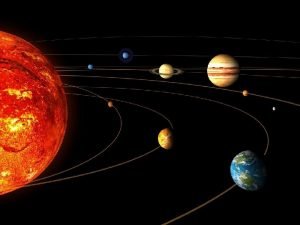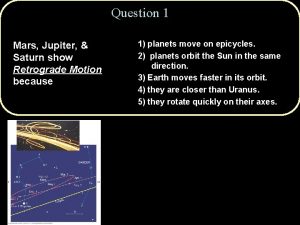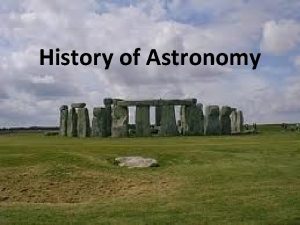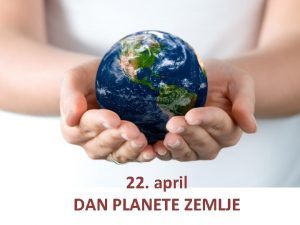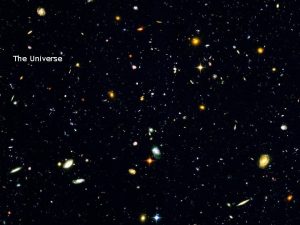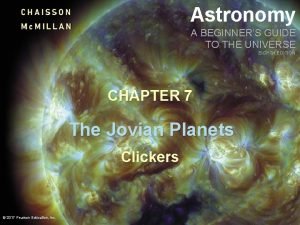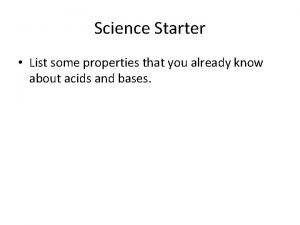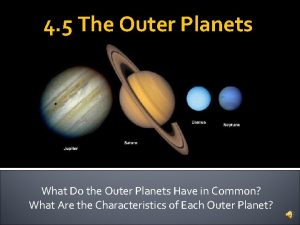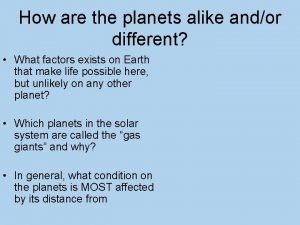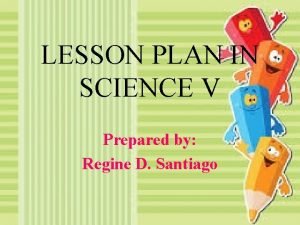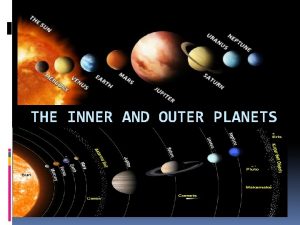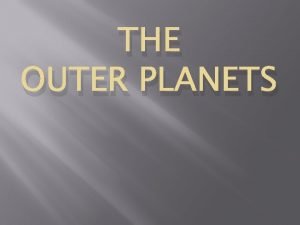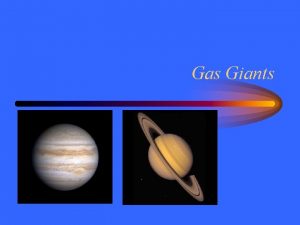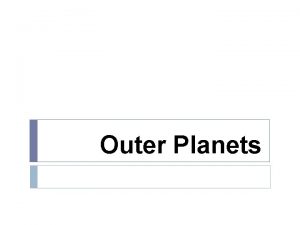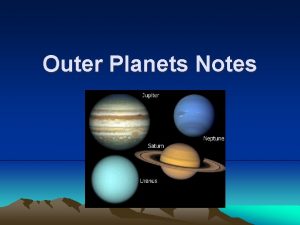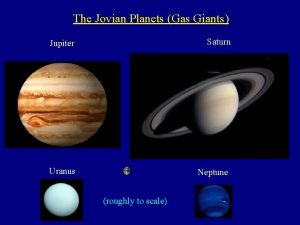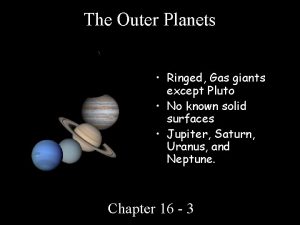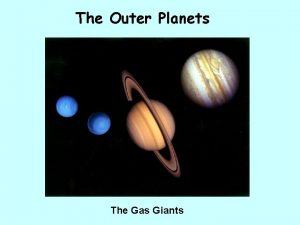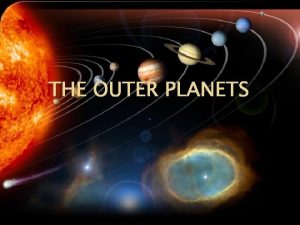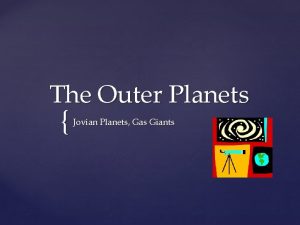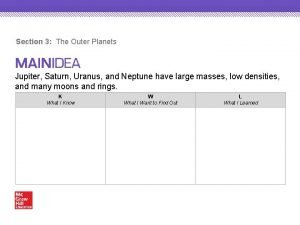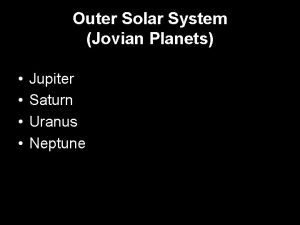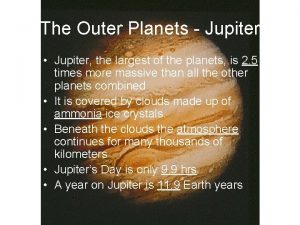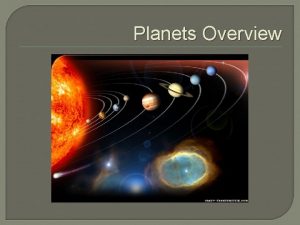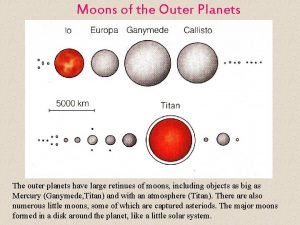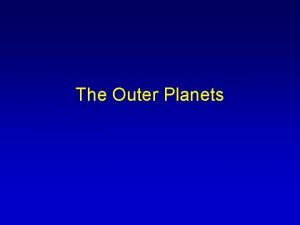The Outer Planets Gas Giants Pluto Jupiter Saturn




















- Slides: 20

The Outer Planets

Gas Giants & Pluto • Jupiter, Saturn, Uranus and Neptune • They are much more massive than Earth • Do not have solid surfaces • Composed of Hydrogen and Helium • Thick atmospheres from strong gravity. • They all have many moons and rings • Pluto is a dwarf planet.

Jupiter • The largest and most massive planet.

Jupiter’s Atmosphere • Thick atmosphere of hydrogen and helium • Great Red Spot- a storm larger than Earth. • Similar to a hurricane but this storm never gets weaker. It has been around since the mid-1600’s.

Jupiter’s Structure • Core of rock and iron. • Thick mantle of hydrogen and helium. • Thick atmosphere.

Jupiter’s Moons • Galileo discovered Jupiter’s 4 largest moons. • They are all larger than Earth’s moon. • Each moon is different. • Jupiter has over 63 moons.

Saturn • The second largest planet in the solar system. • Thick atmosphere. Contains clouds and storms. • Average density is less than water.

Saturn’s Rings • Made of ice and rock. • Each noticeable ring is made up of several thinner rings.

Saturn’s Moons • Largest moon- Titan • Has over 56 moons.

Uranus • 4 times the diameter of Earth. • Very cold. • Blue-green color because there are traces of methane in the atmosphere. • Surrounded by rings.

Discovery of Uranus • Discovered in 1781 • William Herschel proved Uranus was a planet.

Exploring Uranus • Voyager 2 • Discovered that the planet rotates at an angle of 90 degrees from the vertical. • It rotates from top to bottom instead of sideto-side!

Uranus’s Moons • 5 largest moons have icy, cratered surfaces. • Lava flows • At least 27 total moons

Neptune • A cold, blue planet. • Atmosphere contains visible clouds. • Similar in size and color to Uranus.

Discovery of Neptune • Discovered as a result of a mathematical prediction. • They thought an unseen planet (Neptune) was affecting Uranus’s orbit.

Exploring Neptune • Voyager 2 photographed a Great Dark Spot about the size of Earth. • Probably a giant storm. • Storm didn’t last long.

Neptune’s Moons • There at least 13 moons. • Triton is the largest moon. • Triton’s south pole is covered by nitrogen ice.

Pluto • Solid surface. • Much smaller and denser than the outer planets. • Smaller than Earth’s moon! • Has at least 3 moons.

Pluto’s orbit • Very elliptical. • Crosses Neptune’s orbit.

Dwarf Planets • Round and orbits the sun like a planet. • However, dwarf planets have not cleared out the neighborhood around its orbit.
 The first four outer planets do not have solid
The first four outer planets do not have solid What separates the inner planets and outer planets
What separates the inner planets and outer planets What separates the inner planets and outer planets
What separates the inner planets and outer planets Inner planets and outer planets
Inner planets and outer planets Whats the third planet from the sun
Whats the third planet from the sun Jovian worlds
Jovian worlds Mars jupiter and saturn show retrograde motion because
Mars jupiter and saturn show retrograde motion because Mars jupiter and saturn show retrograde motion because
Mars jupiter and saturn show retrograde motion because Neptun saturn
Neptun saturn What are jovian planets made of
What are jovian planets made of Is neptune made of water
Is neptune made of water Saturn is noticeably oblate because
Saturn is noticeably oblate because Solar system inner and outer planets
Solar system inner and outer planets Outer planets
Outer planets Characteristics of outer planets
Characteristics of outer planets What do the four outer planets have in common
What do the four outer planets have in common How are the inner and outer planets alike?
How are the inner and outer planets alike? Inner outer planets venn diagram
Inner outer planets venn diagram Characteristics of outer planets
Characteristics of outer planets Characteristics of outer planets
Characteristics of outer planets What separates the inner and outer planets
What separates the inner and outer planets




